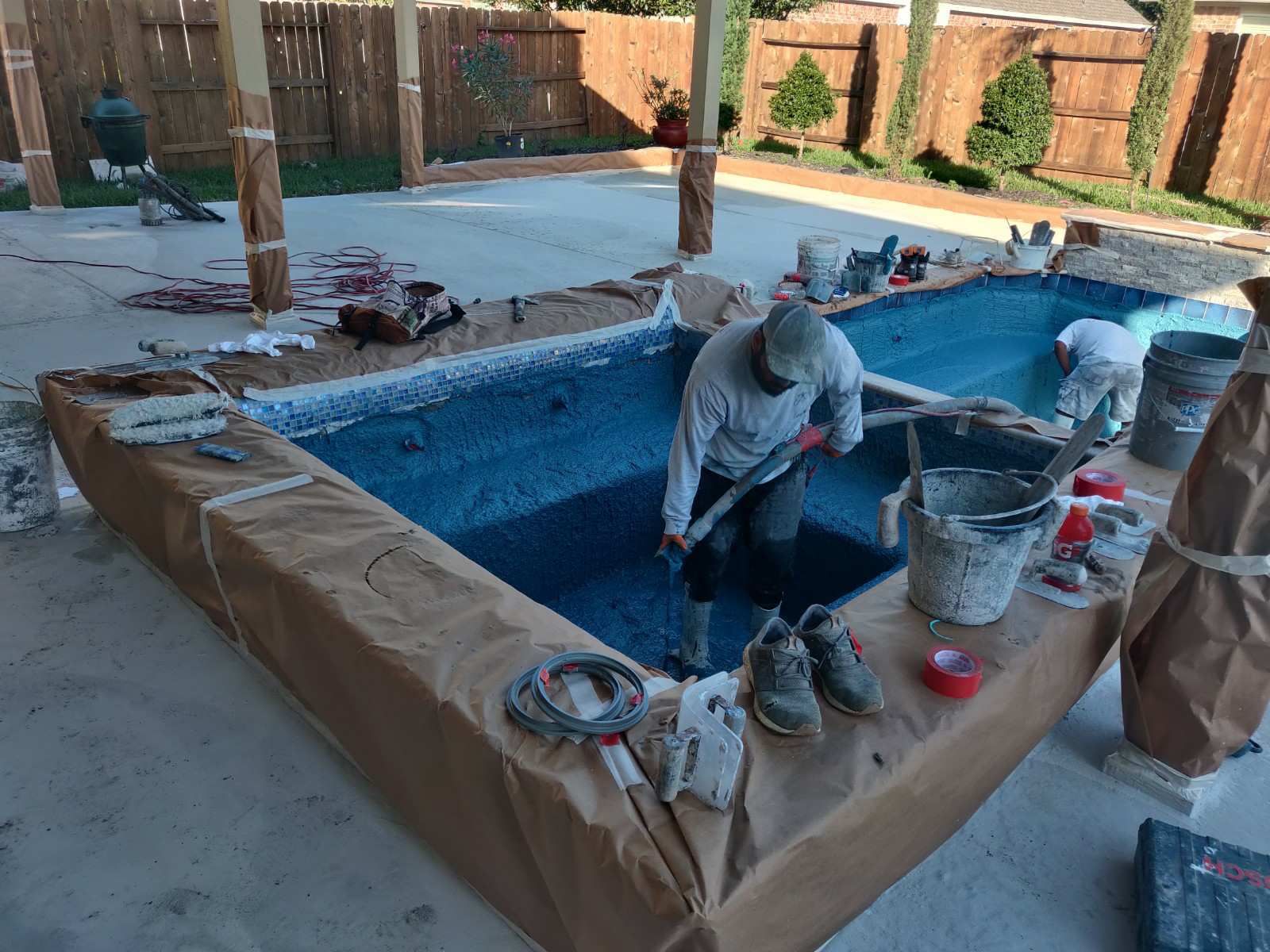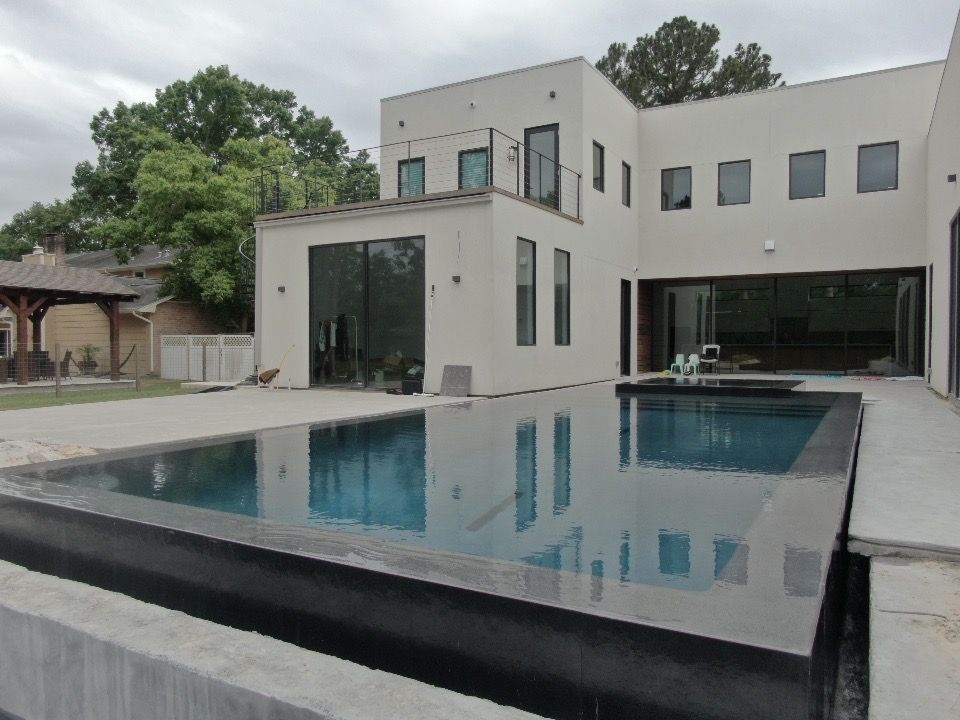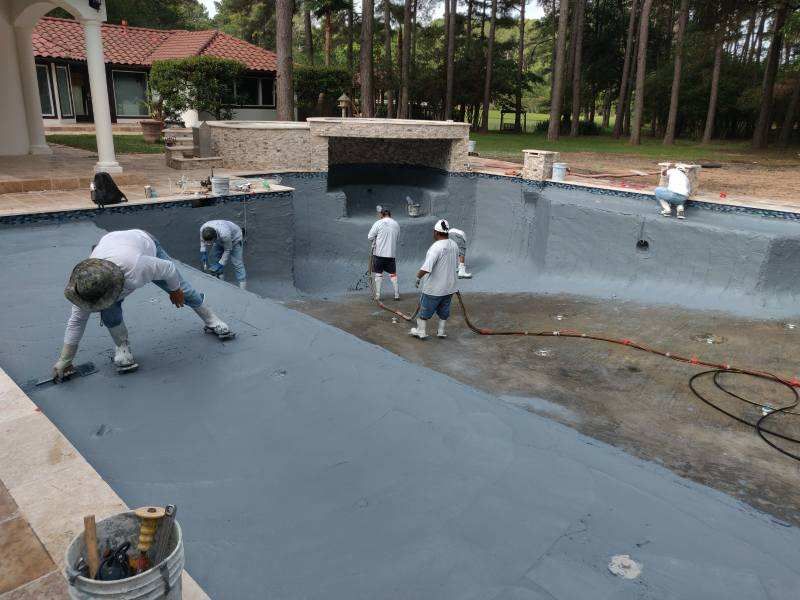Making time to allow someone to re plaster pool Houston, TX is an important part of keeping your pool looking great. Your pool is an extension of your home, beautifying your backyard’s landscape and becoming an additional amenity to your private abode. Although your pool plaster may last a long time, it’ll succumb to the elements eventually, adding rough patches or fading. When the time comes, you should call us to re plaster pool.

Take the chance when you re plaster pool to make some other changes to your pool.
What is pool plaster? Pool plaster is a finish applied to the inside of swimming pools. It is made of cement, sand, and water and has a smooth and waterproof surface. This layer makes the pool look better and helps prevent leaks and damage to the pool’s structure.
Does pool plaster have designs? Of course! Traditional pool plaster is white and provides your pool with a smooth surface. However, you can choose a different plaster color or a completely different material. For example, you can choose aggregate stone or tile.
Whatever plaster you want to re plaster pool with, you can discuss it with JR Pool Plastering & Texas Gunite. We’ll do it for you!
You should schedule a time to replaster your pool when you notice the surface of your pool has worn down. Replastering your pool is not only part of its necessary maintenance, but it could also be a chance for you to change some details.
Since you’re already setting aside time to drain your pool to replaster it, you could remodel your pool in other ways as well. Luckily, JR Pool Plastering & Texas Gunite can do everything for you.
Signs It’s Time to Re Plaster Pool Houston, TX
Updating and maintaining the look and functionality of your swimming pool requires regular repairs and upkeep. Pool plaster is the last and possibly most important layer of your pool. It keeps water out and is the first line of defense against leaks. This perfect surface can wear down over time, so it must be replastered, but how do you know when your pool needs to be resurfaced or retiled again?
First, consider the age of your pool. Standard white plaster lasts between 7 and 10 years on average. It might last twenty years, though, if your pool’s surface was made of a stronger material, like quartz or a mix of pebbles and plaster. That’s why it’s a good idea to check the pool carefully every seven years as a general rule.

Let us show you all of your options when you call us to re plaster pool Houston, TX.
Surface roughness is one of the most familiar visual clues that can tell you a lot. Over time, chemicals, the sun, foot traffic, and cleaning can wear away the plaster layer, leaving a surface that feels more like grit than silk. Swimmers may feel pain and even get cuts and scrapes from this.
Large areas of staining and discoloration on your pool plaster are a sign that the water chemistry balance is off. If your pool’s balance is off for a long time, it can damage the plaster, metal parts, and equipment. Some stains can be removed with treatments or acid cleaning, but this is only a short-term fix.
Replastering is the only long-term fix. Another sign that it’s time to replaster is if the plaster layers are chipping or delaminating, which is also known as “spalling.” Spalling usually happens because the pool water doesn’t have enough calcium.
Cracks or structural breaks, sometimes called “craze cracking,” can also mean that the plaster needs to be replaced. These small cracks appear on the surface of the pool plaster when it shrinks. On the whole, you might want to re plaster pool if you want to make it look better or if you want to use a more lasting plaster material.
Remember that replastering is a big job that usually needs to be done by a professional pool repair and care service. The pool has to be drained, the old plaster has to be chipped off, the new plaster has to be put on and smoothed out, and then the water has to be put back in and balanced.
Still, it’s a good investment. A fresh layer of plaster can bring your pool back to life, making it look better and possibly adding years to its life. When it’s time to re plaster pool, call JR Pool Plastering & Texas Gunite today. We’ll take care of everything for you, from replastering to adding additional pool features.
Ways to Change Your Pool’s Look with a Quick Pool Resurfacing
Since you’ll already be draining your pool to resurface it, this might be the optimal chance to make other changes. Even the slightest change in details can make your outdoor living space look fresh.
For example, even if you only leave it at a simple re plaster pool, the fresh plaster can renew your pool’s original look. Now, what if you took on a slightly more drastic change?
You can change the color of your plaster. Traditionally, plaster is white, but you can make it grey, blue, black, purple, or whatever other color matches the style of your backyard’s design. Typically, the deeper or darker the color, the deeper the pool looks, and vice versa.
So, if you want to give your pool a shallower or deeper look without actually changing the depth, changing the color of your plaster is one way to do it. Changing the actual material of your pool’s surface can give it a different texture.

Let us re plaster pool for you. We bring the best materials and service to your poolside.
For example, you can change it to tile or aggregate stones. Not only will it still protect your pool and give it a smooth surface, but it’ll last longer than standard plaster. And, of course, tiles and stone have many color and design options that can change your pool’s interior.
So, Is It Time For Our Re Plaster Pool Services?
It’s unsafe to leave your pool alone when it starts showing signs of wear and tear. If you leave it alone long enough, you’ll start seeing more spalling or cracks, which could lead to leaks in the pool water. And that will be the start of many ongoing repairs.
Keep it simple and call our team to re plaster pool for you. Luckily, we’re based in Houston, so we can come to you when you call us from anywhere within the city. Let’s get to replastering your pool today!
Houston, Texas Fun Facts:
- Houston is home to the world’s largest medical district.
- Memorial Hermann is the city’s largest nonprofit emergency network.
- St. Joseph’s Hospital is the city’s oldest hospital.
One thought on "Re Plaster Pool | Houston, TX"